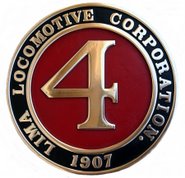
My culinary skills were put to work for the first time since joining the El Dorado Western Railway. Although my occasional meals please its volunteers, they're a side benefit. Demonstration railroads don't need a cook to renovate locomotives and rolling stock.
I was asked to check a standard home oven at the engine house last Saturday. Machinist Sam Thompson wanted to use the oven to pre-heat three cast iron valves for the Diamond and Caldor No. 4 Shay locomotive.
At about 9 a.m., I watched welder Harold Tilton wheel the oven into the engine house on a hand truck. He planned to plug it into the shop's 240-volt receptacle, which is normally used to power the electric arc welder.
Other than a mental note, the fact that Harold was moving the oven didn't register in my brain. Acquired several years ago, the oven hadn't been used to date. I have often though that it could be become the centerpiece of a shop kitchen.

"I had just sat down to preview photographs of the morning's activities when I heard my name.
Where's the oven man?" called Harold. "We need the cook."
I walked into the engine house and looked at the oven, which was set up in the narrow isle between the 39-ton locomotive and a tool cabinet.
"All I can do is to play with the dial." I explained to Harold that my next move has always been to call the kitchen maintenance man in to repair the problem.
As I walked up to the oven, I saw Bill Rodgers, the railway "kitchen maintenance" man, at work. Once we determined that the oven had no power, Bill quickly assessed that the wrong receptacle was connected to the 240-volt power supply.

Bill is our millwright, a jack-of-all-trades shop maintenance man. We've come to depend on his capability to repair almost any piece of shop equipment, including older General Electric electric ovens.
Once Bill repaired the oven, I asked Sam (pictured above, watching Bill repair the receptacle) what he planned to "cook" in the oven.
"As you know," explained Sam, cast iron cracks when intense, local heat is applied to the cold metal. Instead, Sam set the cold valves inside a cold oven. He then turned the oven dial to about 250 degrees.
Once hot, Harold removed each valve one-by-one and braized a layer of brass on each side of the valve. Sam will later machine the valves to the proper specification.
I may use the oven as long as Sam doesn't intend on cooking toxic compounds inside it. The oven and rangetop will come in handy this winter during inclement weather.
There's no reason we can't mix some harmless metallurgy with a bit of precision bread baking in the engine house.
 The El Dorado Western Railroad thanks businessman George Turnboo for his donation of a portable welder to the railroad. The railroad has already placed the portable gas powered Miller welder in service.
The El Dorado Western Railroad thanks businessman George Turnboo for his donation of a portable welder to the railroad. The railroad has already placed the portable gas powered Miller welder in service.





















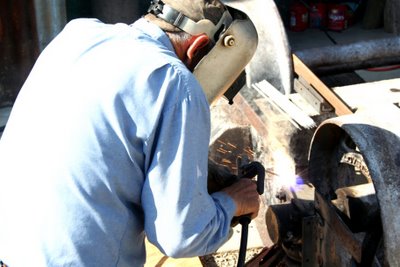 EDWRF welder Dale Mace welds angle iron guides adjacent to one of the Railbus trailer journal boxes. Railway president Eric Stohl said the guides prevent the journal boxes from twisting the wrong way.
EDWRF welder Dale Mace welds angle iron guides adjacent to one of the Railbus trailer journal boxes. Railway president Eric Stohl said the guides prevent the journal boxes from twisting the wrong way. The guides only allow up and down motion, according to Eric. Eric and Dale are the primary crew members on the trailer project. EDWRF vice president Keith Berry has been priming and preparing metal surfaces for paining. He is going to use an oil-based pain from Ace Hardware. The color closest to the original is named Royal Red by Ace.
The guides only allow up and down motion, according to Eric. Eric and Dale are the primary crew members on the trailer project. EDWRF vice president Keith Berry has been priming and preparing metal surfaces for paining. He is going to use an oil-based pain from Ace Hardware. The color closest to the original is named Royal Red by Ace.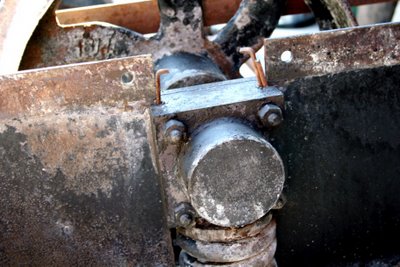
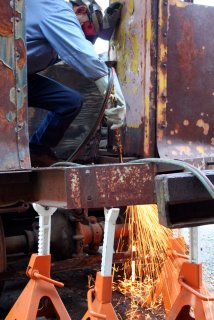
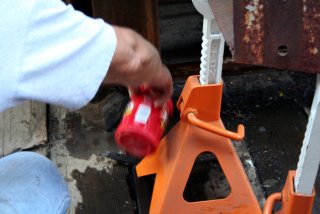 EDWRF President Eric Stohl pours water through the rail planks to douse any fires. Junior railroader Logan manned the bucket brigade after Dale completed his cutting.
EDWRF President Eric Stohl pours water through the rail planks to douse any fires. Junior railroader Logan manned the bucket brigade after Dale completed his cutting.
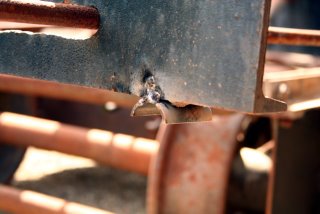
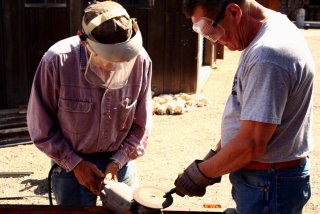 Next, Eric ground the unthreaded end of the both rods. Dale created a mobile grinding wheel by holding the heavy duty grinder while Eric tapered the rod ends.
Next, Eric ground the unthreaded end of the both rods. Dale created a mobile grinding wheel by holding the heavy duty grinder while Eric tapered the rod ends.  The tapered end of the turnbuckle bolt.
The tapered end of the turnbuckle bolt.  Dales uses a piece of angle iron to line the two pieces. He tacks the toe pieces to hold them in place, then completes the weld elsewhere.
Dales uses a piece of angle iron to line the two pieces. He tacks the toe pieces to hold them in place, then completes the weld elsewhere.